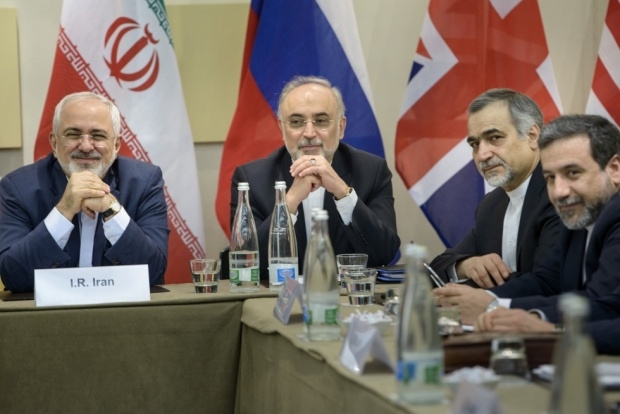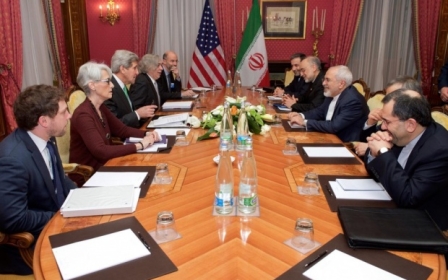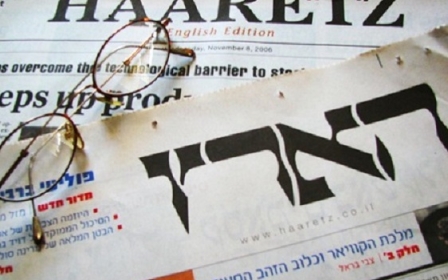Israel’s early nuclear deceit damages Iran nuclear talks today

In the aftermath of the Holocaust, David Ben Gurion determined that Israel must have the ultimate weapon to protect it from Arab enemies who might seek to destroy it. There had been a long history of inter-ethnic conflict and violence in mandatory Palestine between Jews and Arabs beginning after World War I. This culminated in the 1948 War of Independence in which Israel fought against frontline states like Jordan and Egypt. Though Israel ultimately secured its own existence as a result of the war, the price paid was extraordinarily high in lives and treasure.
As a result, from the moment Ben Gurion returned to power for a second term as prime minister in 1955, he directed a mission to develop a nuclear weapon. He entrusted the project to the wily, resourceful defense ministry director general, Shimon Peres, one of his closest aides.
There was an initial debate about whether the bomb should be developed solely using internal resources or whether Israel should turn to outsiders for the raw materials needed to produce such a weapon. It was a crucial debate whose outcome has had a destructive impact on all Israeli nuclear policy up to the present day. Had Israel determined to produce WMD using only its own domestic capability, as Ben Gurion’s science advisor Ernst Bergmann proposed, it would’ve likely taken much longer. Israel would’ve had more control over the entire process devoid of dependence on outside agents. It also might have had the opportunity to be more open about its intent.
But Peres won the argument and determined that Israel would search for whatever funding, products and processes it needed around the world. As Avner Cohen reveals (archival documents published here) in his riveting new account of how Israel pulled the wool over the eyes of US intelligence and diplomats, this search would involve the covert collaboration of Norway, France, the UK, South Africa, Germany, and even the US itself. Because of this complicated effort, and the then-growing international campaign for non-proliferation, secrecy and even deceit became critical elements of the plan.
In most cases, these nations knowingly participated. But in the case of the US, it is likely that Mossad agents, including the future Hollywood producer Arnon Milchan (who allegedly illegally procured US nuclear triggers in the 1980s) and others, stole uranium from a US production plant which was needed for building the bomb.
American Jewish money built Israel’s bomb
In addition, Ben Gurion and Peres turned to wealthy Diaspora Jews to fund the project. Abraham Feinberg, a leading Zionist from New York who made his fortune in the shmatteh (clothing) business, was one of the wealthiest donors to Democratic campaigns. He began by raising money for Lyndon Johnson’s “notoriously corrupt” 1948 Senate campaign. He raised $400,000 for Harry Truman’s 1952 presidential campaign. He and Philip Klutznik raised $500,000 for John F. Kennedy’s 1960 campaign.
According to Seymour Hersh’s interviews with Feinberg, the support came with a “crudely expressed” quid pro quo. Kennedy was not to intrude upon Israel’s nuclear project. When the president, who had made non-proliferation part of his campaign platform, pressed for inspection of the Dimona site, Feinberg fought back vociferously. He told the president that his future fundraising efforts depended on dropping this demand. Kennedy acquiesced.
There are alternate views of this relationship. Cohen believes Kennedy, in his official correspondence, was one of the most unyielding US presidents toward Israel’s nuclear programme. In fact, the day Ben Gurion resigned as prime minister in 1962 the US ambassador was on his way to deliver an ultimatum to the Israelis specifying restraints to be placed on the nuclear programme. Israeli leaders feared that if it did not acquiesce, the US government might revoke tax-exempt status for all donations to Israel. Only months later, Kennedy was assassinated and his successor, Lyndon Johnson, decided not to pursue the matter further.
Abe Feinberg also became chief private fundraiser for the Dimona project itself, raising $40 million (a sum worth roughly $350 million today) to cover the enormous capital, research and construction costs. Though many of the gifts were made through tax-deductible Zionist charities, Feinberg did tell Sy Hersh, when interviewed for his book, The Samson Option, that some of the sums were so vast and the sources of them so suspect, that he adopted various surreptitious means of accepting and transferring them.
For those funds donated legally, the US taxpayer, in much the way hundreds of millions of US charitable dollars today underwrite the Israeli settlement enterprise, subsidised Israel’s bomb.
In return for this great favour, according to a Barron’s report, Israel installed Feinberg on the board of American Bank and Trust in 1963. The state controlled the bank via a Swiss dummy corporation and reportedly had numerous New York City politicians on its payroll. After Coca Cola, which had purportedly acceded to the Arab boycott against Israel, decided it needed to mend its relationship with Jews, Feinberg was rewarded with the country’s lucrative Coca-Cola franchise.
Israel’s nuclear project covertly aided by many nations
Cohen, in his account, portrays Israeli agreements with countries like Norway for supplies of heavy water; and with France for the construction of the Dimona reactor. Die Welt just this week reported a 1960 meeting between Ben Gurion and Konrad Adenauer, Germany’s then-Chancellor, at which Germany agreed to provide $500 million in funding for the nuclear weapons programme. The loan was arranged through a German government-owned bank and was not officially reported or acknowledged. To this day, Shimon Peres, with perhaps a suspect memory, denies knowledge of the incident.
When probed about the terms of Israel’s agreement with France, both parties laid out seemingly ironclad guarantees that the project would have only civilian use and that the extracted plutonium from Dimona would be shipped back to, and controlled by France, and not Israel. This is what Israel told US officials who snooped around asking such questions.
But the promises weren’t worth the paper they were written on: assuming they were written down at all. After Dimona was completed, Israel acted as it wished and ignored any promises it had made.
Dimona as 'textile factory'
One of the most compelling revelations in the new trove of documents released by Cohen and his co-author, William Burr, is that an Israeli finance ministry official joined the US ambassador to Israel, Ogden Reid, on a helicopter flyover of development projects in the Negev. They happened to see the Dimona reactor construction site and Reid asked him what it was. Since the official had sat in an executive meeting in which the Dimona project was discussed, he knew what it was; and also knew he couldn’t tell Reid the truth.
Instead, he told the US diplomat that it was a textile plant, since he knew one actually was being built in the area. For many years after the “textile factory” story entered to lore of lies and half-truths that surrounded the Dimona project.
Dimona came into operation in 1963 and “went critical” in 1964. But the US first confirmed Dimona’s existence in 1960, and had reliable circumstantial evidence even before then of what might be planned there. Hersh believes Eisenhower himself knew of the plant well before he left office, but deliberately chose to look the other way.
In 1956, President Eisenhower had single-handedly forced France, Britain and Israel to retreat from the spoils they’d won in the Sinai War. Clearly, Ike had the power to bring Israel to heel had he wished to. Why didn’t he do more before he left office in 1960 to demand transparency and regulation of Israel’s nuclear effort? Kennedy, who followed him in office, did little more and may have been compromised for reasons portrayed above.
The International Atomic Energy Agency (IAEA) was founded in 1957, based on Eisenhower’s Atoms for Peace legacy. This was as Israel was in the midst of the planning stages for of its nuclear programme. The IAEA’s mission was to direct nuclear programmes to peaceful, rather than military purposes. These efforts culminated in the Nuclear Non-Proliferation Treaty of 1968. By the time it was announced, Israel had already become a nuclear power (in 1967).
Allowing Israel to slip through these cracks was a major failure of the non-proliferation regime. The world, in particular the US, had a chance to demand international inspections. It had a chance to demand that Israel not produce nuclear weapons. It had a chance to require nuclear fuel be sent abroad so it could not be amassed to make weapons. It had a chance to restrict Israeli nuclear efforts to civilian uses and demand that it join NPT. It could’ve stopped the nuclear juggernaut before it even started. It could’ve invoked sanctions against Israel and demanded that France cease its collaboration (which didn’t end till 1966). Instead, it largely remained on the sidelines.
President Nixon reinforced US complicity when, against the advice of senior officials in the Pentagon, he made a tacit agreement with Prime Minister Golda Meir in September 1969 that the US would no longer intrude upon Israel’s nuclear prerogatives in return for Israel maintaining a studied ambiguity on the subject. This policy has held to the present day.
1967: Israel’s first bomb
Two years after Dimona began producing enriched plutonium, Israel had its first crude nuclear device. In the buildup toward the 1967 War, the nation’s nuclear project produced, under emergency circumstances, a handful of such devices meant as a Doomsday weapon, a last resort in case Israel faced catastrophic defeat on the battlefield.
Later, in the early days of the 1973 war, when Israel faced severe losses in Sinai and on the Syrian front, Moshe Dayan even advocated to the security cabinet that it drop a demonstration nuclear weapon in the desert as a warning to its enemies. Luckily for Israel and the world, the cabinet rejected his proposal.
But the spectre of Israeli nuclear weapons continues to hang like a pall over the region. It buttresses Israeli intransigence in the face of demands for compromise to solve its conflicts with its neighbours. It arouses fierce resentment among the Arab nations who reject the notion that Israel deserves such strategic superiority. Undoubtedly, it has fuelled some of the desire among Iranian leaders for their own nuclear capacity (though they, like Israel early in the process, swear they are only interested in civilian uses).
The duplicity Israel exhibited in the early years of its nuclear buildup, which continue to this day with its refusal to acknowledge the existence of its arsenal (estimated between 80-200 warheads), resonate today in the debate over Iran’s nuclear programme.
Israel 1960, Iran 2015
Israel broke many of the promises it made to its partners about its nuclear intentions. It said one thing and did the opposite. Now the world faces questions about Iran’s intentions. It wants to know whether Iran wants a bomb; it wants full IAEA inspections and enriched uranium shipped abroad. It wants assurances that Iran’s nuclear programme will be transparent. Some of the same things many hoped for from Israel 55 years ago but didn’t get.
In considering Iran, the only previous regional model the world has on which to base its approach (Israel) fooled everyone into believing its good intentions. The world doesn’t want to be fooled again.
The world ought to remember that Iran is not Israel. Unlike Israel, Iran has placed its nuclear installations under international supervision (though in several instances it did so after their existence was first exposed). Unlike Israel, it allows inspections (though not always on terms the IAEA demands). Unlike in 1955, the world has far more intelligence capacity to monitor and detect nuclear breakout activity. Unlike Israel, inspections thus far have not turned up any proof that Iran is building a nuclear weapon.
Another important difference is that Iran’s nuclear programme, while it has utilised the expertise of foreign nations like Russia in building the plant at Bushehr, is largely domestically driven. Iran uses whatever materials and resources it can find around the world. But the sanctions regime has forced it to rely on its own internal devices. This in turn means that the outside world has less control over or knowledge of what Iran does.
A theme often raised by opponents of the Iranian regime is the level of official corruption, smuggling and duplicity countenanced by Iran’s leaders in circumventing the sanctions regime. One hears about oil flowing illegally through Turkish pipelines (there have even been credible reports of Israeli purchases of Iranian oil in contravention of sanctions), massive smuggling enterprises sponsored by the Revolutionary Guards, and Iranian black market trade to secure parts for its nuclear facilities (which Israeli and US intelligence utilised to smuggle sabotaged parts that damaged the Iranian plants and equipment). Whatever one thinks of these activities, one must remember the massive amount of deceit and even outright theft that contributed to the Israeli nuclear effort. And what’s good for the goose should also be good for the gander.
Those alarmed by Iran’s nuclear programme and who believe that country is concealing its intent to create nuclear weapons like to point to its alleged duplicity in hiding secret installations like Fordo. But we should remember that Israel did precisely the same thing regarding Dimona. Even worse, it refused any regular inspections of Dimona and actually used the reactor to create its nuclear arsenal. The nuclear framework announced in Lausanne provides for such inspections at Fordo and restraints on the activities that may go one there. These are things Israel never agreed to regarding its own facility.
The cataclysm scenario
There is another distinct similarity between the two programmes: just as Israel adopted a policy of opacity about the question of its nuclear weapons arsenal, so Iran has adopted a similar approach. Ayatollah Khameini has publicly renounced, even denounced, nuclear weapons, calling them un-Islamic. But some observers believe that Iran wants to be a threshold nuclear state. Unlike Israel, it doesn’t want to build or possess a nuclear arsenal. But it may want to put in place the infrastructure to assemble a nuclear weapon should it need one, in the case of an existential threat. Japan is a state which is reputed to have the ability to produce a nuclear weapon within six months should it face a similar threat. But it would only use it in the case of averting a military cataclysm. This may be Iran’s thinking as well.
If the proposed P5+1 deal fails either at the bargaining table or through Congressional rejection, it will drive Iran further underground. Instead of an agreement that restrains nuclear development, it will be open season. Iran will expand its centrifuge development, create newer, faster models that enrich fuel at far higher speeds. You could see Iran become the second nuclear power in the region.
As I write this, there are multiple conflicts raging in the region: Iraq, Syria, Yemen, Israel-Palestine. Over the years, millions have died. In each of these conflicts there are primary parties who are proxies for larger powers. Israel accuses Iran of being one of these powers. But it neglects to acknowledge that it has (and had) its own proxies: the South Lebanon Army, al Nusra, and Hezbollah and Hamas in their earliest iterations.
The Middle East is a powder keg. Given the devastation wrought by conventional war, does the world really wish to add another nuclear-armed state to the mix? Wouldn’t it be smarter and safer to learn a lesson from Israel circa 1960? Think of what the US could’ve done then but refused to do. Wouldn’t the region have been a far safer place with no nuclear weapons?
Shouldn’t we now integrate Iran into the political "power-grid" of the Middle East? Instead of demonising it and treating it as a pariah state, wouldn’t there be more to gain from collaboration and cooperation? There have been murmurings in the media emanating from White House sources that President Obama is aware of these issues. He’d like to build on a successful nuclear deal by forging a new relationship with Iran. But before he gets there he has to navigate the exceedingly tricky shoals of Iranian hardliners and GOP-Israel lobby hawks who each seek failure for their own reasons.
- Richard Silverstein writes the Tikun Olam blog, devoted to exposing the excesses of the Israeli national security state. His work has appeared in Haaretz, the Forward, the Seattle Times and the Los Angeles Times. He contributed to the essay collection devoted to the 2006 Lebanon war, A Time to Speak Out (Verso) and has another essay in the upcoming collection, Israel and Palestine: Alternate Perspectives on Statehood (Rowman & Littlefield).
The views expressed in this article belong to the author and do not necessarily reflect the editorial policy of Middle East Eye.
Photo: Iranian representatives at nuclear talks at Lausanne, Switzerland (AFP)
New MEE newsletter: Jerusalem Dispatch
Sign up to get the latest insights and analysis on Israel-Palestine, alongside Turkey Unpacked and other MEE newsletters
Middle East Eye delivers independent and unrivalled coverage and analysis of the Middle East, North Africa and beyond. To learn more about republishing this content and the associated fees, please fill out this form. More about MEE can be found here.





